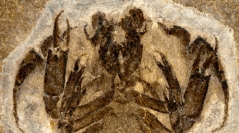

 European Journal of Taxonomy
2017 (367) - Pages 1-23 (EJT-367)
European Journal of Taxonomy
2017 (367) - Pages 1-23 (EJT-367)Polychelidan lobsters (Decapoda: Polychelida) are crustaceans with extant species which are restricted to deep water environments. Fossil species, however, used to live in more varied palaeoenvironments, from shallow water to deep water, and were more diverse morphologically. We redescribe two species of polychelidan lobsters, the Late Triassic Rosenfeldia triasica Garassino, Teruzzi & Dalla Vecchia, 1996 and the Late Jurassic Eryon oppeli Woodward, 1866, recently assigned to the same genus, Rosenfeldia, based upon only a few characters. Our investigation of all available material of both species leads us to distinguish these two species and to erect Rogeryon gen. nov. to accommodate Eryon oppeli. The palaeobiology of both species is interpreted for the first time. Rosenfeldia triasica with its stout first pereiopods and mandibles with both incisor and molar processes (documented for the first time in Polychelida) was benthic and probably fed either on slow-moving sedentary preys or was a scavenger. Rogeryon oppeli gen. et comb. nov. was benthic, visually adapted to shallow water palaeoenvironments, and possibly had a diet similar to that of slipper lobsters and horseshoe crabs. The redescription of these two species highlights the palaeobiological diversity of fossil polychelidans.
Decapoda, palaeoecology, Solnhofen, Jurassic, Triassic.